小学英语一年级M2U1知识整理
部编版一年级下册英语全册知识点汇总

部编版一年级下册英语全册知识点汇总
1. 单词:
- 根据课文内容和研究目标,一年级下册英语单词主要包括动物、食物、家庭成员、颜色、数字等基本词汇。
2. 语法:
- 一年级下册英语语法主要集中在基本的句型和词序的研究上,学生需要研究熟练掌握基本的肯定句、否定句、疑问句等。
3. 句型:
- 一年级下册英语句型主要包括短句和简单的对话,通过研究
这些句型,学生可以在交流中基本表达自己的意思。
4. 对话:
- 一年级下册英语对话主要以日常生活场景为背景,例如问候、购物、问路、家庭活动等,通过对话的研究,学生可以提高口语表
达能力。
5. 课文内容:
- 一年级下册英语课文内容涵盖了较多的日常生活场景和常用
词汇,通过课文的研究,学生可以扩大词汇量,增加语言运用能力。
6. 听力和口语:
- 一年级下册英语注重听力和口语训练,通过听力材料和口语练,学生可以提高自己的听力理解和口语表达能力。
7. 练题:
- 一年级下册英语全册的知识点汇总中还包括相关的练题,通
过练题的完成,学生可以进一步巩固所学的知识,培养英语研究的
兴趣和自学能力。
以上是部编版一年级下册英语全册知识点的汇总,希望对学生
的英语学习有所帮助。
译林版一年级下册全册英语知识点梳理
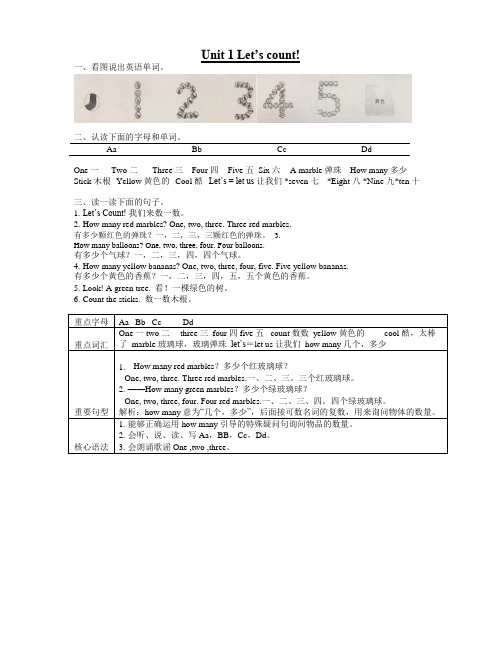
Unit 1 Let’s count!一、看图说出英语单词。
二、认读下面的字母和单词。
Aa Bb Cc DdOne 一Two 二Three 三Four 四Five 五 Six 六 A marble 弹珠How many 多少Stick 木根Yellow 黄色的Cool 酷Let’s = let us 让我们 *seven 七*Eight 八 *Nine 九*ten 十三、读一读下面的句子。
1.Let’s Count! 我们来数一数。
2.How many red marbles? One, two, three. Three red marbles.有多少颗红色的弹珠?一,二,三,三颗红色的弹珠。
3.How many balloons? One, two, three, four. Four balloons.有多少个气球?一,二,三,四,四个气球。
4.How many yellow bananas? One, two, three, four, five. Five yellow bananas.有多少个黄色的香蕉?一,二,三,四,五,五个黄色的香蕉。
5.Look! A green tree. 看!一棵绿色的树。
6.Count the sticks. 数一数木根。
重点字母Aa Bb Cc DdOne 一 two 二three 三 four 四 five 五 count 数数 yellow 黄色的cool 酷,太棒重点词汇了 marble 玻璃球,玻璃弹珠let’s=let us 让我们 how many 几个,多少1.--How many red marbles?多少个红玻璃球?--One, two, three. Three red marbles.一、二、三。
三个红玻璃球。
2.——How many green marbles?多少个绿玻璃球?--One, two, three, four. Four red marbles.一、二、三、四。
最新部编版一年级英语下册各单元重点知识点总结(全册)

最新部编版一年级英语下册各单元重点知识点总结(全册)第一单元:Hello!1. 研究用英语问候方式:Hello,Hi,Good morning,Good afternoon,Good evening。
2. 研究用英语介绍自己的名字:What's your name? My nameis ...3. 研究用英语介绍自己的国家:Where are you from? I'm from ...第二单元:Colours1. 研究颜色词汇:red,blue,yellow,green,purple,pink,brown,black,white,orange。
2. 研究用英语询问颜色:What colour is it? It's ...3. 研究用英语表达自己喜欢的颜色:What's your favourite colour? My favourite colour is ...第三单元:Schoolbag1. 研究单词:schoolbag,pencil case,book,ruler,eraser,pen,pencil。
2. 研究用英语询问和回答“这是什么?”的问题:What's this? It'sa ...第四单元:Toys1. 研究单词:teddy bear,doll,toy car,ball,balloon。
2. 研究用英语询问和回答“你有什么玩具?”的问题:What toys do you have? I have a ...第五单元:Food1. 研究单词:hamburger,hot dog,pizza,noodles,rice,sandwich,cake,juice,water。
2. 研究用英语询问和回答“你想吃什么?”的问题:What do you want to eat? I want to eat ...第六单元:Actions1. 研究动词:jump,run,swim,read,write,sing,dance,draw,listen,eat。
一年级英语知识点归纳总结2024
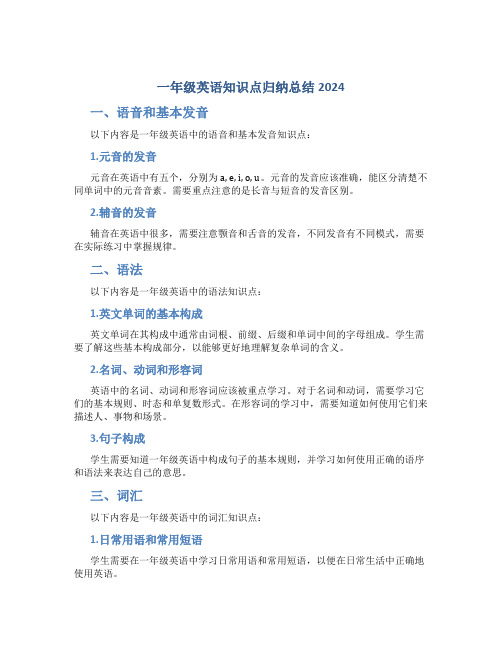
一年级英语知识点归纳总结2024
一、语音和基本发音
以下内容是一年级英语中的语音和基本发音知识点:
1.元音的发音
元音在英语中有五个,分别为a, e, i, o, u。
元音的发音应该准确,能区分清楚不同单词中的元音音素。
需要重点注意的是长音与短音的发音区别。
2.辅音的发音
辅音在英语中很多,需要注意颚音和舌音的发音,不同发音有不同模式,需要在实际练习中掌握规律。
二、语法
以下内容是一年级英语中的语法知识点:
1.英文单词的基本构成
英文单词在其构成中通常由词根、前缀、后缀和单词中间的字母组成。
学生需要了解这些基本构成部分,以能够更好地理解复杂单词的含义。
2.名词、动词和形容词
英语中的名词、动词和形容词应该被重点学习。
对于名词和动词,需要学习它们的基本规则、时态和单复数形式。
在形容词的学习中,需要知道如何使用它们来描述人、事物和场景。
3.句子构成
学生需要知道一年级英语中构成句子的基本规则,并学习如何使用正确的语序和语法来表达自己的意思。
三、词汇
以下内容是一年级英语中的词汇知识点:
1.日常用语和常用短语
学生需要在一年级英语中学习日常用语和常用短语,以便在日常生活中正确地使用英语。
2.数字
了解英文数字在日常生活中的使用方式,以帮助学生更好地理解和使用英语数字。
3.时令词汇和节日单词
学生需要掌握一些与季节或节日相关的词汇,以便在相关场合用英语表达。
以上是一年级英语中的基本知识点的概述,学生需要通过实践和学习而稳步掌握这些内容,以提高在英语学习和英语交流中的能力。
一年级英语知识点梳理
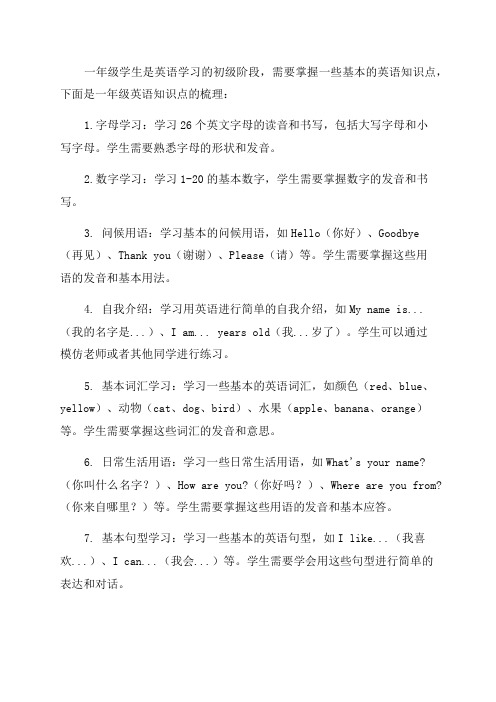
一年级学生是英语学习的初级阶段,需要掌握一些基本的英语知识点,下面是一年级英语知识点的梳理:1.字母学习:学习26个英文字母的读音和书写,包括大写字母和小写字母。
学生需要熟悉字母的形状和发音。
2.数字学习:学习1-20的基本数字,学生需要掌握数字的发音和书写。
3. 问候用语:学习基本的问候用语,如Hello(你好)、Goodbye(再见)、Thank you(谢谢)、Please(请)等。
学生需要掌握这些用语的发音和基本用法。
4. 自我介绍:学习用英语进行简单的自我介绍,如My name is...(我的名字是...)、I am... years old(我...岁了)。
学生可以通过模仿老师或者其他同学进行练习。
5. 基本词汇学习:学习一些基本的英语词汇,如颜色(red、blue、yellow)、动物(cat、dog、bird)、水果(apple、banana、orange)等。
学生需要掌握这些词汇的发音和意思。
6. 日常生活用语:学习一些日常生活用语,如What's your name?(你叫什么名字?)、How are you?(你好吗?)、Where are you from?(你来自哪里?)等。
学生需要掌握这些用语的发音和基本应答。
7. 基本句型学习:学习一些基本的英语句型,如I like...(我喜欢...)、I can...(我会...)等。
学生需要学会用这些句型进行简单的表达和对话。
8.数字计数:学习用英语进行基本的数字计数,如1-10的数字,学生需要掌握这些数字的发音和书写。
9. 日常活动:学习一些与日常活动相关的词汇,如吃饭(eat)、睡觉(sleep)、玩耍(play)等。
学生需要掌握这些词汇的发音和意思,并能用英语进行简单的描述。
10.基本对话:学习一些基本的对话表达,如问候、介绍自己、询问他人的基本信息等。
学生需要掌握这些对话表达的发音和应答。
以上是一年级英语知识点的梳理,希望对学生能够有所帮助。
小学一、二年级英语知识点整理

一年级(上)单词:固定词组:wave hello 挥手打招呼wave goodbye 挥手再见want to+动词想要做...例句1:want to play?想要玩吗?Thank you\thanks 谢谢你Point to 指向例句1:point to my fingers 指向我的手指Watch out 小心\当心常用句型:I’m+姓名:我叫XXX例句1:I’m Emma 我叫爱玛例句2:I’m Susen 我叫苏森Who are you:你是谁?I’m a\an+名词:我是一个XXX例句1:I’m a boy 我是一个男生例句2:I’m a monkey 我是一个猴子This is my+名词:这是我的XXX例句1:this is my mom 这是我的妈妈例句2:this is my grandma 这是我的外婆例句3:this is my family 这是我的家人——How old are you你多少岁了?——I’m+数字我XX岁例句1:——how old are you ?你几岁了?——I’m seven 我7岁了二年级(上)单词:固定词组:Look at看例句1:look at my toys 看我的玩具例句2:look at this red jacket 看这件红色的夹克衫in+地方名词:在XX地方例句:It’s very hot in HaiNan 在海南非常热Here it is :它在这里It’s=it isbest of all:最、最好的例句:I like the robot best of all 这些玩具我最喜欢的是机器人How about you? 你呢?你怎么样呢?Pick out 选出、挑出例句:pick out your clothes 挑出你的衣服常用句型:This is +姓名:这是+人名(向别人介绍这是谁谁...)例句:This is Emma 这是爱玛Let’s+动词:我们一起去做xxx例句:let’s go我们出发吧\let’s play我们一起玩吧——how are you?:你好吗?——good,thanks:我很好,谢谢——what’s your name? 你叫什么名字——my name’s+姓名\I’m+姓名:我叫XXX例句:——what’s your name? 你叫什么名字——my name’s Jack我的名字叫杰克——或I’m Bill 我叫比尔Nice to meet you:见到你很高兴(初次见面礼貌用语)——how many?(问数量\多少个)——回答数字例句1:——how many? 多少个?——five 5个例句2:——how many colors?——four!例句3:——how many?——three,three balls——What is it?这是什么东西?——it’s an\a+名词这是一个XXX例句:——what is it?这是什么?——it’s an apple这是一个苹果——或it’s an orange 这是一个橙子——或it’s a pear 这是一个梨人的名字‘s+名词:谁的xxxx例句1:Jack’s monster 杰克的怪物例句2:Emma’s doll 爱玛的洋娃娃——Is it a\an+名词:这是xxx吗?——(肯定回答)yes,it is是的,它是——(否定回答)no,it isn’t不,它不是(isn’t=is not)例句1:Is it a train ? yes,it is例句2:Is it a car?No,it isn’t. it’s a truck.There’s a\an +名词:这里有一个XXX例句:there’s a car 这里有一辆小汽车It’s+颜色:它是XXX颜色(it’s=it is)例句1:it’s red 它是红色例句2:it’s yellow 它是黄色They’re+颜色(they're=they are)例句1:they’re purple 他们是紫色例句2:they're orange 他们是橙色This+名词+is+颜色:这个...是XXX颜色例句1:this skirt is yellow 这件短裙是黄色的例句2:this shirt is purple 这件衬衫是紫色的These+名词+are+颜色:这些...是XXX颜色例句1:these shoes are red 这些鞋子是红色的例句2:these pants are blue 这些长裤是蓝色的二年级(下)单词:固定词组:ride a bike 骑自行车play soccer 踢足球play the piano 弹钢琴day and night 早上和晚上常用句型:主语+can+动词:某某能做...例句1:he can swim 他能游泳例句2:I can fly 我能飞主语+can’t+动词:某某不能做...例句1:she can’t walk 她不能走路例句2:I can’t run 我不能跑步Can you+动词:你能做...吗?Yes,I can:是的,我能No,I can’t:不,我不能例句1:Can you ride a bike?你能骑自行车吗?Yes,I can是的,我能例句2:Can you play the piano?你能弹钢琴吗?No,I can’t 不,我不能I like+名词:我喜欢...例句1:I like burgers.我喜欢汉堡例句2:I like carrots.我喜欢胡萝卜I don’t like+名词:我不喜欢...例句1:I don’t like mouse 我不喜欢老鼠Do you like+名词:你喜欢....吗?——yes,I do 是的,我喜欢——no,I don’t 不,我不喜欢例句1:Do you like orange juice?你喜欢橙汁吗?Yes,I do 是的,我喜欢例句2:Do you like tea?你喜欢茶吗?No,I don’t 不,我不喜欢。
小学英语1-6年级要点知识点汇总(期末特别整理)

小学英语1-6年级要点知识点汇总(期末特别整理)第一部分:基础知识1.字母:26个字母的大小写ABCDEFGHIJKLMNOPQRSTUVWXYZabcdefghijklmnopqrstuvwxyz2.语音:元音的发音五个元音字母:AEIOU12个单元音:前元音:[i:] [ɪ] /e/ [æ]中元音:[ɜ:] [ə]后元音:[ɑ:] [ɒ] [ɔ:] [u :] [ʊ] [ʌ]双元音(8个)Ⅰ.合口双元音(5个)[ai] [ei] [au] [əu] [ɔi] Ⅱ.集中双元音(3个)[iə][εə][uə]3.词汇:词汇量,近反义词4.句子:大小写,标点符号第二部分:语法知识一.名词:名词单复数,名词的格(一)名词单复数1.一般情况,直接加-s,如:book-books, bag-bags, cat-cats, bed-beds2.以s. x. sh. ch结尾,加-es,如:bus-buses, box-boxes, brush-brushes, watch-watches3.以“辅音字母+y”结尾,变y为i, 再加-es,如:family-families,strawberry-strawberries4.以“f或fe”结尾,变f或fe为v, 再加-es,如:knife-knives5.不规则名词复数:man-men, woman-women, policeman-policemen, policewoman-policewomen, mouse-micechild-children, foot-feet, tooth-teeth,fish-fish, people-people, Chinese-Chinese, Japanese-Japanese不可数名词的复数就是原型:paper, juice, water, milk, rice, tea(二)名词的格(1) 有生命的东西的名词所有格:a) 单数后加’s 如: Lucy’s ruler my father’s shirtb) 以s 结尾的复数名词后加’如: his friends’ bagsc) 不以s 结尾的复数后加’s children’s shoesl并列名词中,如果把’s加在最后一个名词后,表示共有, 如:Tom and Mike’s car 汤姆和迈克共有的小汽车l要表示所有物不是共有的,应分别在并列名词后加’sTom’s and Mike’s cars 汤姆和麦克各自的小汽车(2)表示无生命东西的名词通常用“ of +名词”来表示所有关系:如:a picture of the classroom a map of China第二部分:语法知识二.冠词:不定冠词,定冠词种类:(1)不定冠词:a / an a un it / an uncle元音开头的可数名词前用an :an egg / an apple / an orange / an eraser / an answer / an ID card / an alarm clock / an actor / an actress / an e-mail / an address / an event / an example / an opera / an houran old man / an interesting book / an excitin g sport / an action movie / an art lesson /(2)定冠词:the the egg the plane2. 用法:定冠词的用法:(1)特指某(些)人或某(些)物:The ruler is on the desk.(2)复述上文提到的人或物:He has a sweater. The sweater is new.(3)谈话双方都知道的人或物:The boys aren’t at school.(4)在序数词前:John’s birthday is February the second.(5)用于固定词组中:in the morning / afternoon / evening不用冠词的情况:(1)专有名词前:China is a big country.(2)名词前有定语:this , that , my , your , some, any , no 等:This is my baseball.(3)复数名词表示一类人和事:Monkeys can’t swim. They are teachers.(4)在节日,日期,月份,季节前:Today is Christmas Day. It’s Sunday.(5)一日三餐前:We have breakfast at 6:30.(6)球类棋类运动前:They often play football after class. He plays chess at home.* 但乐器前要用定冠词:I play the guitar very well.(7)学科名称前:My favorite subject is music.(8)在称呼或头衔的名词前:This is Mr Li.(9)固定词组中:at noon at night by bus第二部分:语法知识三、代词、形容词、副词代词:人称代词,物主代词人称代词物主代词主格宾格第一人称单数I(我)memy(我的)复数we(我们)usour(我们的)第二人称单数you(你)youyour(你的)复数you(你们)youyour(你们的)第三人称单数he(他)himhis(他的)she(她)herher(她的)it(它)itits(它的)复数they(他们/她们/它们)themtheir(他们的/她们的/它们的)形容词,副词:比较级,最高级(一)、形容词的比较级1、形容词比较级在句子中的运用:两个事物或人的比较用比较级,比较级后面一般带有单词than。
上海小学牛津英语1A一年级上册详细知识点
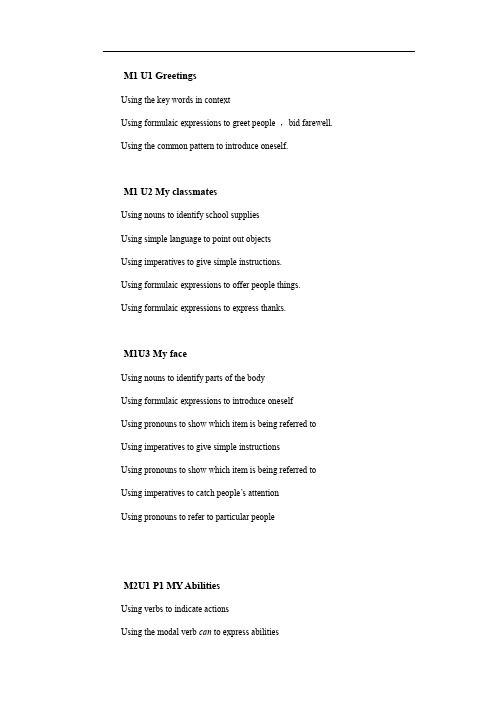
M1 U1 GreetingsUsing the key words in contextUsing formulaic expressions to greet people ,bid farewell. Using the common pattern to introduce oneself.M1 U2 My classmatesUsing nouns to identify school suppliesUsing simple language to point out objectsUsing imperatives to give simple instructions.Using formulaic expressions to offer people things.Using formulaic expressions to express thanks.M1U3 My faceUsing nouns to identify parts of the bodyUsing formulaic expressions to introduce oneselfUsing pronouns to show which item is being referred to Using imperatives to give simple instructionsUsing pronouns to show which item is being referred to Using imperatives to catch people’s attentionUsing pronouns to refer to particular peopleM2U1 P1 MY AbilitiesUsing verbs to indicate actionsUsing the modal verb can to express abilitiesAsking wh-questions to find out a person’s ability. E.g., What can you do?Using verbs to indicate actions. E.g., I can sing.M2U2 My familyUsing pronouns to identify people. E.g., meUsing nouns to identify family members. E.g., mother, father, grandfather, grandmotherUsing nouns to identify family membersUsing possessive adjectives to express possessionAsking wh-questions to find out a person’s identityUsing pronouns to identify peopleUsing formulaic expressions to confirm or denyM2U3 My friendsUsing adjectives to describe people. E.g., thin, fat, tall, shortUsing pronouns to identify peopleUsing adjectives to describe peopleAsking wh-questions to find out a person’s identityUsing the modal verb can to express abilitiesM3U1 In the classroomUsing numerals to count from one to sixUsing numerals to show quantityUsing numerals to count from one to sixUsing numerals to show quantityAsking questions to find out quantity?M3U2 In the fruit shopUsing nouns to identify fruit.e.g., apple, pear, peach, orangeAsking questions to find out quantitye.g., How many..?Using formulaic expressions to request something.Using formulaic expressions to reply requestsUsing formulaic expressions to express thanksM3U3 In the restaurantUsing nouns to identify food.e.g., pizza, hamburger, cake, pieHear specific information in response to simple questions.e.g., Give me a hamburger, please. Here you are.Using formulaic expressions to request somethingUsing an indefinite article to refer to somethingUsing formulaic expressions to greet customersM4U1 On the farmUsing nouns to identify common farm animalsUsing some onomatopoeic words to imitate the sounds of the farm animalsUsing verbs to give instructionsUsing the key pattern to role-play as farm animalAsking wh-questions to find out specific information about something Using a pronoun to refer to somethingM4U2 In the zooUsing nouns to identify animalsUsing adjectives to describe things.Asking yes/no questions to obtain simple responses.e.g., Is this a bear?Using formulaic expressions to confirm or deny.e.g., Yes./No. It’s a panda.M4U3 In the parkUsing adjectives to identify colours.e.g., It’s red.Asking wh-questions to find out the colours of objects.e.g., what colour is it?Using adjectives to identify coloursUsing imperatives to give simple instructionsUsing onomatopoeic words to indicate animal soundsUsing adjectives to describe animalsAsking wh-questions to find out specific information about an animal.。
一年级英语重点总结
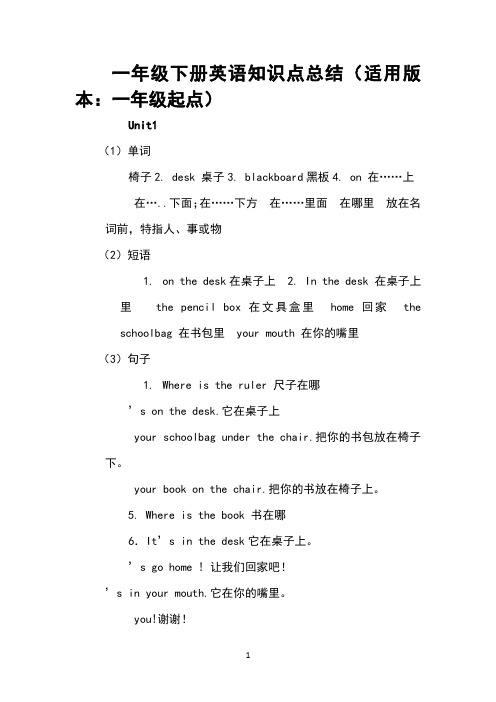
一年级下册英语知识点总结(适用版本:一年级起点)Unit1(1)单词椅子2. desk 桌子3. blackboard黑板4. on 在……上在…..下面;在……下方在……里面在哪里放在名词前,特指人、事或物(2)短语1.on the desk在桌子上2. In the desk 在桌子上里the pencil box 在文具盒里home 回家theschoolbag 在书包里 your mouth 在你的嘴里(3)句子1.Where is the ruler 尺子在哪’s on the desk.它在桌子上your schoolbag under the chair.把你的书包放在椅子下。
your book on the chair.把你的书放在椅子上。
5. Where is the book 书在哪6.It’s in the desk它在桌子上。
’s go home ! 让我们回家吧!’s in your mouth.它在你的嘴里。
you!谢谢!my pencil box in the schoolbag.把我的铅笔盒放进书包里。
my ruler in the pencil box.把我的尺子放进铅笔盒里。
Unit2(1)单词灯床门;出入口箱子;盒子靠近,接近在……背后(2)短语the door 在门后 chair 一把椅子 bird 一只鸟 the light 在灯附近 a gift for you 给你一份礼物 it 找到它 the bed 在床上(3)句子1.What’s behind the door 在门后的是什么2. What’s under the desk 在桌子下的是什么3. What’s near the light 在灯附近的是什么have a gift for you .我有一份礼物送给你and find it 走并找到它。
Unit3(1)单词1.Plane 飞机球玩偶;玩具娃娃列车;火车小汽车;轿车玩具熊;熊可以;能够当然对不起,抱歉(2)短语a car 拥有一辆小汽车 a bear拥有一个玩具熊.7.。
部编小学一年级英语M1--M4单元知识整理

部编⼩学⼀年级英语M1--M4单元知识整理else 其他的aeroplane = plane飞机spinner 转盘circle 圆圈tooth ⽛齿(单)teeth ⽛齿(复)toothpick ⽛签spin 转by=beside 在…旁边child ⼉童(单)children ⼉童(复)raindrop ⾬点pitter-patter ⾬声(象声词)bus 巴⼠(单)buses 巴⼠(复)同⾳词:hear -- here see -- sea (⼤海) by -- buy -- bye there -- their易混淆:ship -- sheep bus -- boop van -- beep car -- beep bicycle -- ding / ting 词组:an aeroplane ⼀架飞机spin the spinner 转转盘fall down 落下来what else 其他什么make a spinner 做⼀个转盘tell your classmates 告诉你的同学们draw a circle 画⼀个圆cut a circle 剪⼀个圆colour the circle给圆涂⾊use a toothpick 使⽤⼀根⽛签by the window 在窗旁some children ⼀些孩⼦们a toy car ⼀辆玩具⼩车much rain 许多⾬many raindrops 许多⾬点sit on the chair 坐在椅⼦上his chick 他的⼩鸡句型:1. What can you hear? I can hear a ship.What else can you hear? I can hear an aeroplane.2. I can’t see them, but I can hear them.⼉歌:Charlie has a chick. Charlie has a chair.Charlie and his chick are sitting on the chair.rough -- smooth soft -- hard同⾳词:to -- too -- two单词:touch 触摸feel 感觉pineapple 菠萝glass 玻璃杯(单)glasses(复)hungry 饥饿的thirsty 渴的food ⾷物fruit ⽔果finger ⼿指foot 脚(单数)feet 脚(复数)bread ⾯包supermarket 超市词组:a glass of water ⼀杯⽔two glasses of milk 两杯⽜奶some bread ⼀些⾯包much bread 许多⾯包this one 这个that one 那个ask and answer 问⼀问,答⼀答on the Moon 在⽉亮上in the sun 在阳光下go and get some food 去买些⾷物Moon bread Moon pie ten Moon yuan too hard 太硬了句型:1. Touch the bread. How does it feel? = How does the bread feel?It’s rough and soft. / It feels rough and soft.2. Touch the glasses. How do they feel? = How do the glasses feel?They’re smooth and hard.3. This banana is soft, but that one isn’t.4. What is this/that? It’s Moon bread.What are these/those? They’re Moon pies.5. How much are the Moon cakes? They are eleven Moon yuan.How much is the Moon pineapple? It is twelve Moon yuan.6. I like the Moon pie. Me too.7. What can you do with your hands and fingers?I can touch and feel with my hands and fingers.⼉歌:I can see a shop. I can see the ships.How many ships (are there) in the shop?One, two, three, four, five, six.Come and see the six ships in the shop.范⽂:In the fruit shopKitty: Dad, look. Here is a fruit shop. There is much food in it. Let’s buy some fruit. Mr. Li: OK.shop assistant: Welcome to the fruit shop! What can I do for you?Mr. Li: Kitty, what do you like?Kitty: I like bananas, Dad. Oh, look. The plums are so fresh.Mr. Li: Do you like the plums?Kitty: Yes, I like them very much.Mr. Li: OK. Let's buy some plums and bananas.Excuse me. May I have some plums, please?shop assistant: Sure. How many plums do you want?Mr. Li: Fifteen plums, please.shop assistant: Here you are.Mr. Li: Thank you. And eight bananas, please. How much are they?shop assistant: The plums are eighteen yuan and the bananas are eleven yuan. So the plums and the bananas are twenty-nine yuan.Mr. Li: Here you are.shop assistant: Thank you.Mr. Li: Bye-bye.M1U3 Tasting and smelling单词:sweet 甜的/ 糖果lemon 柠檬sour 酸的watermelon 西⽠salt 盐(不可数)salty 咸的coffee 咖啡(不可数)bitter 苦的fruit ⽔果sometimes 有时whale 鲸鱼photograph=photo 照⽚its 它的tail 尾巴反义词:sweet -- sour sweet -- bitter hot -- coldwarm -- cool dry -- wet词组:at / in the fruit shop 在⽔果店⾥at night 在夜晚sleep right = sleep well 睡得好much fruit 许多⽔果句型:1. How does the lemon smell? It’s nice.How do the lemons smell? They’re nice.2. How does the salt taste? It’s salty.How do the sweets taste? They’re sweet.3. May I have some apples, please? Sure.4. How many plums do you want? I want twelve plums.5. How much is the watermelon? It’s thirteen yuan.How much are the pineapples? They’re fourteen yuan.6. Don’t drink the coffee at night or you can’t sleep right.⼉歌:1.It can be bitter. It can be sweet.Sometimes it’s black. Sometimes it’s white.Don’t drink it at night or you can’t sleep right.2.What can you see in the photograph?I can see Mr. White.I can see his toy whale and its white tail.M2U1 Animals单词:favourite 最喜爱的thing 东西animal 动物clever 聪明的strong 强壮的bull 公⽜zoo 动物园circus 马戏团uncle叔叔hat 圆边帽many/much许多some ⼀些so 如此的very ⾮常rest 休息take拿angry⽣⽓的finally 最后season 季节kind(形)善良的/(名)种类get 取/得到clock钟rock ⽯头say 说tick-tock 钟声(象声词)want 想要词组:look at 看看many hats 许多圆边帽⼦much jam 许多果酱take a rest=have a rest 休息⼀下a kind of ⼀种many kinds of 许多种all kinds of 所有种类的... under the tree 在树下get the hat back 取回圆边帽sit on a rock 坐在⽯头上six clocks 六个钟six o’ clock 六点钟jump into the tree 跳进树⾥take the hat 拿了这个圆边帽so strong 多么强壮on a warm spring day 在⼀个温暖的春⽇Uncle Bai ⽩叔叔on a hot summer day 在⼀个炎热的夏⽇Auntie Wang 王阿姨on a cool autumn day 在⼀个凉爽的秋⽇Grandpa Li 李爷爷on a cold winter day 在⼀个寒冷的冬⽇句型:1. I like the dogs. 特指喜欢的是这些狗I like dogs. 喜欢的是所有的狗I like the dog. 特指喜欢的是这只狗2. Do you like monkeys? Yes, I do. / No, I don’t.3. Does he like elephants? Yes, he does. / No, he doesn’t.⼉歌:Jack is sitting on a rock. He has a clock. It goes tick-tock, tick-tock.‘Six o’clock! Six o’clock!’ Says the chick in the clock.范⽂:Animals in the zooIt’s Sunday morning. What a fine day! The sun is shining in the sky. My friend Jack and I go to the zoo. We go there by bus. Oh! Here we are. We can see all kinds of animals in the zoo. Lions, tigers, bears and so on. I like monkeys very much because they’re so clever. But Jack doesn’t like them because they’re a little naughty. He likes pandas best. Look! The zebras are under the trees. The tigers are by the pond. How strong they are!M2U2 Toys单词:t oy 玩具skateboard 滑板lovely 可爱的train ⽕车robot 机器⼈box(boxes)foil 锡箔纸glue 胶⽔button 纽扣stick 粘Ron ⼈名together ⼀起fun 有趣的walk ⾛super 超级的wall 墙behind 在…后⾯glue 胶⽔易混淆单词:doll 娃娃-- ball 球doll 娃娃-- door 门反义词:behind在…后⾯-- in front of 在…前⾯in 在..⾥⾯-- out 在..外⾯inside 在..⾥边-- outside 在..外边on上⾯-- under 下⾯词组:toy train 玩具⽕车make a robot 制作⼀个机器⼈play with your friend 和你的朋友⼀起玩a piece of foil ⼀张锡纸 a bottle of glue ⼀瓶胶⽔take some boxes 拿⼀些盒⼦let’s = let us 让我们stick the foil on the boxes 把锡纸粘在盒⼦上very well ⾮常好have fun 玩得愉快walk the dog 遛狗stand behind the wall 站在墙的后⾯Ron the robot机器⼈Ron play together ⼀起玩句型:1.What toy do you like? I like skateboards.What toy do your friends like? They like robots.What toy does your friend like? He/She likes toy trains.2.Let’s play together!3.I’m sorry. It’s OK.= That’s all right.⼉歌:A small ball and a tall wall.The small ball is on the wall.A small girl and a tall boy.They are standing behind the wall.范⽂:How to make a robotI can make a lovely robot. I need a piece of foil, a bottle of glue, some boxes and some buttons to make a robot.First, I stick the foil to the boxes. The foil is silver. It is shiny and smooth. It can make the robot more beautiful.Secondly, I stick the boxes together. The big box can be the body of the robot. The small boxes can be the head, the hands and the legs. How wonderful!Thirdly, I stick the buttons to the boxes. I put the buttons on the robot’s head and its body. They can be the eyes, the nose and the mouth. The two black buttons are the eyes of the robot. The big button is the nose of the robot. And the four buttons are the mouth of the robot. Wow, it looks funny! It is a super robot.I call it Ron the robot. The robot’s name is interesting, isn’t it? I like it very much. The robot is my favourite toy.The dog and the catToday is Sunday. It’s a sunny day. Mr. Dog and Mr. Cat go to the park together. They play on the grass. Mr. Dog likes skateboards. Look, he can ride it very well. It’s fun! But Mr. Cat doesn’t like skateboards. He likes robots. He has a superrobot. I t can walk. It can dance. It can run. It can do many things. It can make Mr. Cat happy.The robot walks on the grass. Mr. Dog rides his skateboard on the grass too. Suddenly(突然),the skateboard bumps(碰撞) the robot. Mr. Dog falls down the skateboard.He is very sad. He is crying: Mr. Cat feels sorry about this. He says,’I’m s orry. Are you OK?’ Mr. Dog says, ‘That’s all right. But I don’t like robots at all! The robot is not fu n!’Favourite toyKally’s favorite toy is a robot. It looks like a man. It is made of paper and foil. It’s super. She likes playing with it.Ben is Kally’s friend. His favourite toy is the puzzle. It is funny. He can do the puzzles. It makes him clever. It’s good for him.LEGO is a kind of toys. It’s made of bakelite. We can ma ke a lot of things with it, such as a plane, a car a big ship, a giraffe and a pair of shoes. How wonderful it is! Now many kids in the world like to play with it. Because their parents think it can make them more clever. It’s good for them.trousers 长裤(复数)hat 圆边帽jacket 夹克衫scarf 围⼱(scarves) glove ⼿套(⼀只)sock 袜⼦(⼀只)shoe 鞋⼦(⼀只)English 英语Chinese 中⽂Japanese ⽇语try 尝试toe 脚趾tongue ⾆头giraffe 长颈⿅miss 错过Miss ⼩姐hurry赶紧classroom教室glass 玻璃(不可数)clean 擦⼲净together ⼀起beside = by 在…旁边易混淆单词:clothes ⾐服总称-- cloth 布料-- clothe 穿⾐toe -- tongue反义词:here -- there this -- that these -- thoseclean -- dirty词组:a pair of trousers ⼀条长裤(单数) a pair of gloves ⼀双⼿套(单数)a pair of socks ⼀双袜⼦(单数) a pair of shoes ⼀双鞋⼦(单数)a pair of glasses ⼀副眼镜(单数)two pairs of shorts 两条短裤like reading = like to read 喜爱读ride a horse = ride horses 骑马read the English words 读英语单词in English ⽤英语want to ride my horse 想要骑马clean the glass 擦玻璃my toy giraffe 我的玩具长颈⿅--(复)our toy giraffesMiss Tang 唐⼩姐句型:1.What is this / that? It is a pair of trousers.What are these / those? They are trousers.What are these / those? They are two pairs of trousers.2.What is this in English? 这⽤英语怎么说?It’s a hat.3.May I have a try? Sure.4.Peter can read the English words for ‘hat’ and ‘horse’.Peter能读英语单词“帽⼦”和“马”Hurry! Hurry! Miss Tang. Don’t miss the bus.The pupils are in the classroom. They are cleaning the glass.circle 圆形square ⽅形/⼴场triangle 三⾓形star 星型rectangle 长⽅形heart ⼼形angle ⾓度side 边shape 形状fan 电扇/歌迷light 灯反义词:open -- close turn off 关上-- turn on 打开turn up ⾳量调响-- turn down ⾳量调轻bright 明亮-- dark ⿊暗take off 脱下-- put on 穿上词组:after school 放学后-- before school 上学前be like = look like 像句型:1.Here is some cakes for you. Thank you.Here are some bread for you. Thank you.2.What shape is it? It is a rectangle.What shape are they? They are rectangles.3.We are home.4.How many stars are there in the picture? There are four stars. What’s in the picture? There are five triangles.5.What is a rectangle like? It’s like a book.What are the squares like? They are like clocks.6. I can use shapes to make a house. = I can make a house with shapes.I use shapes to make a horse. = I make a horse with shapes.⼉歌:Turn off the fan. We are cold.Turn off the light. It is bright.Take of the coat. It is so hot.violet 紫罗兰rainbow 彩虹mountain ⼭sea 海river 河ant 蚂蚁grasshopper 蚱蜢sleep睡觉plant 种植/植物反义词:inside – outside lazy 懒惰的-- hardworking 勤劳的come in -- go out hot -- coldwarm – cool dry -- wetLu Mountain 庐⼭Yangtze River 长江Yellow River 黄河on a sunny day 在⼀个晴天on a cloudy day 在⼀个多云天much grass 许多草in spring/ summer/ autumn/winter an ant ⼀只蚂蚁on a plate 在盘⼦⾥in warm clothes 穿着温暖的⾐服句型:1.What colour is the sky on a cloudy day? It’s gray/grey.What colour are the leaves in autumn? They’re red and yellow.⼉歌:One, two, three, what can you see?I can see Clare and Gladys. They are in warm clothes。
外研社小学英语一年级知识点【上下册】
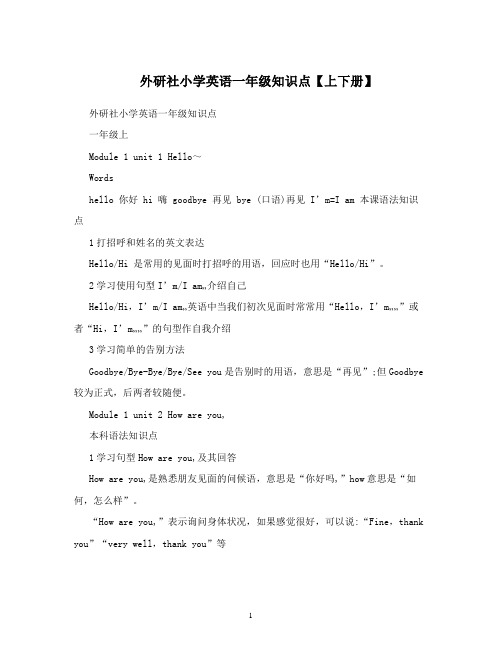
外研社小学英语一年级知识点【上下册】外研社小学英语一年级知识点一年级上Module 1 unit 1 Hello~Wordshello 你好 hi 嗨 goodbye 再见 bye (口语)再见I’m=I am 本课语法知识点1打招呼和姓名的英文表达Hello/Hi 是常用的见面时打招呼的用语,回应时也用“Hello/Hi”。
2学习使用句型I’m/I am…介绍自己Hello/Hi,I’m/I am…英语中当我们初次见面时常常用“Hello,I’m……”或者“Hi,I’m……”的句型作自我介绍3学习简单的告别方法Goodbye/Bye-Bye/Bye/See you是告别时的用语,意思是“再见”;但Goodbye 较为正式,后两者较随便。
Module 1 unit 2 How are you,本科语法知识点1学习句型How are you,及其回答How are you,是熟悉朋友见面的问候语,意思是“你好吗,”how意思是“如何,怎么样”。
“How are you,”表示询问身体状况,如果感觉很好,可以说:“Fine,thank you”“ver y well,thank you”等当别人问“How are you,”时,你可以回答:“I’m fine,thanks,and you,”“And you,”意思是“你怎么样呢,”,对方如何身体很好,可以回答:I’m fine,too.(我也很好。
) Module 2 unit 1 What’s your name,Wordsgood 好的 morning 早晨,上午what’s=what is 是什么 my 我的 name 名字本课语法知识点1学习如何自我介绍和如何询问他人姓名Good morning是早上见面打招呼所用的句子,意思是“早上好”,good是“好”的意思;别人向你说Good morning时,你也要用Good morning来回答。
一年级第二学期英语Unit1重点知识

一年级第二学期英语Unit1重点知识一年级第二学期英语第一单元知识学习完了,那么有哪些知识点呢?下面就是小编为大家整理的Unit1重点知识,希望对大家有所帮助!词汇hen母鸡 chick小鸡 duck鸭子 cow母牛 sheep绵羊pig猪 nose鼻子 orange橙 paper纸ground地面moo(牛叫声) oink(猪叫声) quack(鸭叫声) cluck(母鸡叫声)draw画画 see看见 hear听见 frog青蛙 bird鸟rabbit兔子 butterfly蝴蝶 bee蜜蜂 egg蛋have got有farm农场 animal动物句子1.Draw the hen and chick on the T-shirt.2.Draw the duck on the balloon.3.Draw the sheep and cow on the paper.4.Draw the bee on the egg.5.Draw the butterfly on the pig. Draw the pig on the ground.6.Draw the orange on your left arm.7.What do you see? I see some frogs in the water.How many frogs? Three.8.What do you see? I see some eggs on the ground.How many eggs? Three eggs.9.What do you hear? I hear some birds.10.What do you hear? I hear a pig.Is it thin? No, it is not. It is fat.Is it pink? Yes, it is.11.What do you hear? I hear a cow. Is it fat? Yes, it is.12.A cow goes “moo,moo”. A pig goes “oink,oink”.A duck goes “quack,quack”. A hen goes “cluck,cluck”.13.I‘ve got a chick and a hen.14.I’ve got a pig and a cow。
精品一年级各单元英语知识点学习
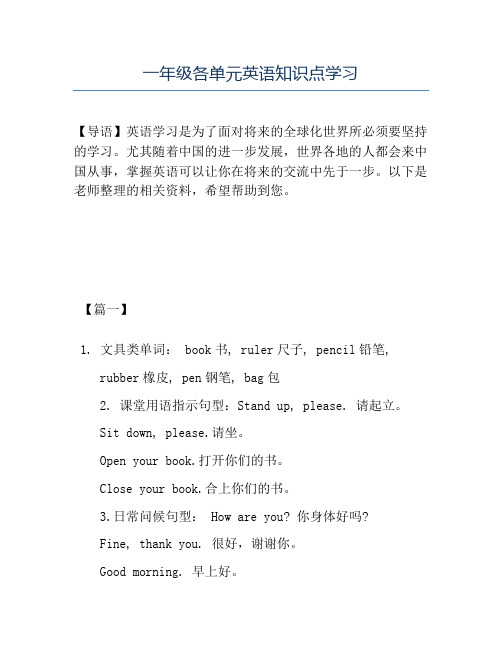
一年级各单元英语知识点学习【导语】英语学习是为了面对将来的全球化世界所必须要坚持的学习。
尤其随着中国的进一步发展,世界各地的人都会来中国从事,掌握英语可以让你在将来的交流中先于一步。
以下是老师整理的相关资料,希望帮助到您。
【篇一】1. 文具类单词: book书, ruler尺子, pencil铅笔,rubber橡皮, pen钢笔, bag包2. 课堂用语指示句型:Stand up, please. 请起立。
Sit down, please.请坐。
Open your book.打开你们的书。
Close your book.合上你们的书。
3.日常问候句型: How are you? 你身体好吗?Fine, thank you. 很好,谢谢你。
Good morning. 早上好。
4.韵律诗: ____, ____, I can see. _____, _____, for you and me!5.儿歌:Good morning拓展内容:school bag书包Good afternoon. 下午好。
Good evening.晚上好And you? 你呢? I'm fine, too.我也很好。
【篇二】1.数字单词:one 1, two 2, three 3, four 4, five 5, six 62.借物品句型:Give me a rubber, please. 请给我一块橡皮。
Give me a pencil, please. 请给我一支铅笔。
3.介绍人物句型: Hi, May. This is Tim. 你好,梅. 这是Tim.Hello, I'm May. 你好,我是梅.Hello. May. 你好,梅.4.听口令: Show me给我看… clap拍手…. Say说….How many..? 多少…?5.韵律诗:One two three, it's a tree. Four five six, pick up sticks.【篇三】1.能力单词:read读,write写, draw画sing唱, dance跳舞, jump跳2. 课堂用语指示句型: Raise your hand. 举手。
外研社一年级下册 M1u2知识点
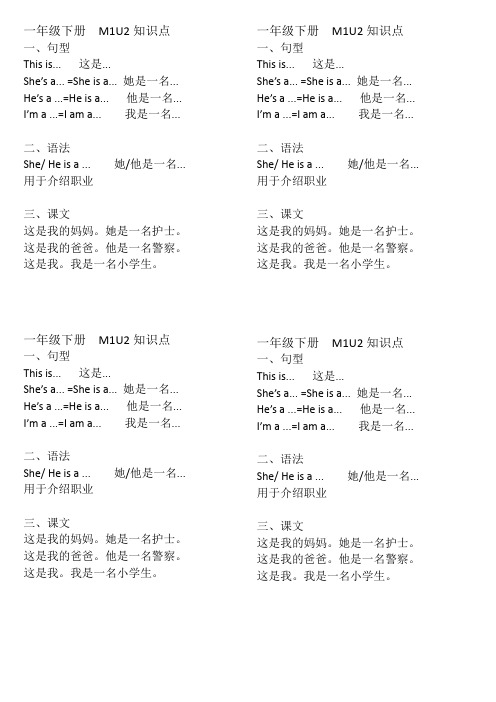
一年级下册M1U2知识点一、句型This is... 这是...She’s a... =She is a... 她是一名... He’s a ...=He is a... 他是一名... I’m a ...=I am a... 我是一名...二、语法She/ He is a ... 她/他是一名... 用于介绍职业三、课文这是我的妈妈。
她是一名护士。
这是我的爸爸。
他是一名警察。
这是我。
我是一名小学生。
一年级下册M1U2知识点一、句型This is... 这是...She’s a... =She is a... 她是一名... He’s a ...=He is a... 他是一名... I’m a ...=I am a... 我是一名...二、语法She/ He is a ... 她/他是一名... 用于介绍职业三、课文这是我的妈妈。
她是一名护士。
这是我的爸爸。
他是一名警察。
这是我。
我是一名小学生。
一年级下册M1U2知识点一、句型This is... 这是...She’s a... =She is a... 她是一名... He’s a ...=He is a... 他是一名... I’m a ...=I am a... 我是一名...二、语法She/ He is a ... 她/他是一名... 用于介绍职业三、课文这是我的妈妈。
她是一名护士。
这是我的爸爸。
他是一名警察。
这是我。
我是一名小学生。
一年级下册M1U2知识点一、句型This is... 这是...She’s a... =She is a... 她是一名... He’s a ...=He is a... 他是一名... I’m a ...=I am a... 我是一名...二、语法She/ He is a ... 她/他是一名... 用于介绍职业三、课文这是我的妈妈。
她是一名护士。
这是我的爸爸。
他是一名警察。
这是我。
我是一名小学生。
2021年小学一年级下册英语知识点归纳
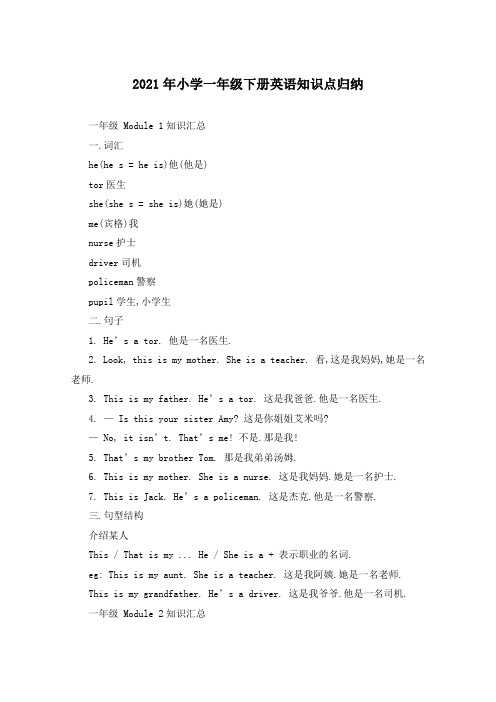
2021年小学一年级下册英语知识点归纳一年级 Module 1知识汇总一.词汇he(he s = he is)他(他是)tor医生she(she s = she is)她(她是)me(宾格)我nurse护士driver司机policeman警察pupil学生,小学生二.句子1. He’s a tor. 他是一名医生.2. Look, this is my mother. She is a teacher. 看,这是我妈妈,她是一名老师.3. This is my father. He’s a tor. 这是我爸爸.他是一名医生.4. — Is this your sister Amy? 这是你姐姐艾米吗?— No, it isn’t. That’s me! 不是.那是我!5. That’s my brother Tom. 那是我弟弟汤姆.6. This is my mother. She is a nurse. 这是我妈妈.她是一名护士.7. This is Jack. He’s a policeman. 这是杰克.他是一名警察.三.句型结构介绍某人This / That is my ... He / She is a + 表示职业的名词.eg: This is my aunt. She is a teacher. 这是我阿姨.她是一名老师.This is my grandfather. He’s a driver. 这是我爷爷.他是一名司机.一年级 Module 2知识汇总一.词汇where(where’s = where is)哪里(在哪里)in在......里on在......上hat帽子under在......下toy玩具bed床look at看bear熊二.句子1. — Where’s the bird? 鸟在哪?— It’s in my hat. 它在我的帽子里.2. It’s on my hat. 在我的帽子上面.3. It’s under my hat. 在我的帽子下面.4. — Where’s the pencil? 我的铅笔在哪?— It’s under the book. 它在书下面.5. Look at your bed. The bear is under the bed. 看你的床下.熊在你的床底下.6. — Is it a bag? 它是一个书包吗?— No, it isn’t. 不,不是.三.固定搭配look at ...eg: Look at the book. 看这本书.四.句型结构询问某物的位置— Where is ...?— It’s on / in / under ...eg:— Where is my coat? 我的外套在哪?— It’s on the sofa. 在沙发上.— Where is the cat? 小猫在哪?— It’s under the chair. 在椅子下面.一年级 Module 3知识汇总一.词汇eleven十一twelve十二don t = do not 不know知道other其他的fish鱼tree树let s让我们二.句子1. How many cats? 多少只猫呢?2. — Where’s the orange cat? 橘色的猫在哪?— I don’t know. 我不知道.3. — Is it under the bed? 在床底下吗?— Yes, it is. 是的,在床底下.4. — How many green birds? 多少只绿色的鸟?— Four green birds. 四只绿色的鸟.5. Let’s count. 让我们数一数.三.句型结构① 询问数量How many + 可数名词复数?eg:— How many black cats? 多少只黑色的猫?— Ten. 十只.— How many white crayons? 多少支白色的蜡笔?— Si_. 六支.② 询问某物是否在某地— Is + 可数名词单数 + in / on / under + 其他?— Yes, it is. / No, it isn’t.eg:— Is the duck in the river? 鸭子在河里吗?— No, it isn’t. 不,不在河里.— Is the schoolbag under the bed? 书包在床下面吗?— Yes, it is. 是的,在床底下.一年级 Module 4知识汇总一.词汇head头touch触摸nose鼻子face脸ear耳朵mouth嘴eye眼睛body身体these这些leg腿hand手feet(foot的复数形式)脚;足baby婴儿二.句子1. This is my head. 这是我的头.2. Touch your nose. 摸摸你的鼻子.3.— What are these? 这些是什么?— These are your eyes. 这些是你的眼睛.4. This is Bobo. This is his head. 这是波波,这是他的头.5. Point to his leg. 指一指他的腿.三.句型结构① 介绍自己的身体部位This is my + 身体部位的名词.eg:This is my mouth. 这是我的嘴.This is my head. 这是我的头.This is my hand. 这是我的手.② 询问〝这些是什么?〞— What are these?— They are ...eg: — What are these? 这些是什么?— They are pandas. 他们是熊猫.— What are these? 这些是什么?— They are stars. 它们是星星.一年级 Module 5知识汇总一.词汇they他(她/它)们they re = they are他(她/它)们是cow奶牛pig猪farm农场duck鸭子chicken鸡egg鸡蛋,蛋thin瘦的very很,非常fat胖的big大的little小的二.句子1. Look, a pink dog. 看,一只粉色的猪.2. — Look at these. What are they? 看这些.他们是什么?— They’re cows. 他们是奶牛.3. These are chickens. 这些是鸡.4. Look at the father pig. It’s fat. 看猪爸爸,它是胖的.5. That is the mother. It’s thin. 那是猪妈妈.它是瘦的.6. These are his ears. They’re big. 这些是他的耳朵,耳朵是大的.7. They’re monkeys. They’re thin. 他们是猴子.他们是瘦的.三.句型结构① 询问〝他们是什么〞— What are they?— They are ...eg: — What are they? 他们是什么?— They are cows. 他们是奶牛.② 描写某种动物的大小胖瘦(big / small / fat / thin)eg: Pandas are fat. 熊猫是胖的.The monkey is thin. 猴子是瘦的.一年级 Module 6知识汇总一.词汇snake蛇short矮的,短的small小的elephant大象go去zoo动物园long长的giraffe长颈鹿tall高的tiger老虎cute可爱的,乖巧的strong强壮的horse马aren t = are not不,不是二.句子1. The elephant is very big. 大象非常大.2. Let’s go to the zoo. 我们去动物园吧.3. — Look at these snakes. Are they long? 看这些蛇,他们长吗?— Yes, they are. 是的,他们很长.4. — Look at these giraffes. Are they tall? 看这些长颈鹿.他们高吗?— Yes, they are. And I’m short. 是的.他们高.我们很矮.5. The monkey isn’t strong. 猴子不是强壮的.6. The bear is very strong. 熊非常强壮.7.— Look at the baby horses. Are they big? 看这些马宝宝.他们大吗?— No, they aren’t. They’re little and cute. 不,他们不大.他们小巧可爱.三.句型结构① 描写某种动物(tall / short / strong ...)eg: The tiger is strong and big. 老虎很强壮很大.The cat is little and cute. 猫小巧可爱.② 询问某种动物是否具有某个特点— Are these + 动物名称的复数形式 + 形容词?— Yes, they are. / No, they aren’t.eg: — Are these bears strong? 熊很强壮吗?— Yes, they are. 是的,他们是强壮的.— Are giraffes tall? 长颈鹿高吗?— Yes, they are. 是的,他们是高的.一年级 Module 7知识汇总一.词汇there is有,存在animal动物can可以,能see看见there are有,存在help帮助over there在那边table桌子we我们miaow(猫)喵喵叫some一些at在二.句子1. How many animals can you see? 你能看见多少动物?2. There is an elephant under the tree. 有一只大象在树下.3. There is a cat in the tree. It’s a cute cat. 树上有只猫,是一只可爱的猫.4. Let’s help the cat. 我们帮帮这只猫吧.5. There is a chair over there. 那边有把椅子.6. There are two brown monkeys. 有两只棕色的猴子.7. There are so many animals at the zoo. 动物园里有如此多的动物.三.句型结构① There is + 可数名词单数/不可数名词 + 其他.eg: There is a big garden in my house. 我家有一个大花园.There is a strong bear in the zoo. 动物园里有只很壮的熊.② There are + 可数名词复数 + 其他.eg: There are many trees on the hill. 山坡上有许多树.There are many birds in the sky. 天空中有许多鸟.一年级 Module 8知识汇总一.词汇a pair of一双......,一对......shorts(常复)短裤shirt衬衫shoe鞋子swim游泳OK行,好sock短袜put on穿上,戴上clothes(常复)衣服here这里football足球(运动)basketball篮球(运动)ping-pong乒乓球(运动)二.句子1. There’s a pair of shorts under that duck. 有一条短裤在那只鸭子下面.2. Let’s put on our clothes! 让我们穿上衣服吧!3.— Where are my shoes? 我的鞋子在哪?— There’s a pair of shoes over there. 有双鞋在那.4. There’s a basketball under my chair. 有个篮球在我的椅子底下.5. There are five ping-pong balls here. 这儿有五个乒乓球.6. There are two shirts on the bed. 床上有两件衬衫.三.句型结构① The re is + 可数名词单数/不可数名词 + 其他.eg: There is a boat on the lake. 湖面上有一艘船.② There are + 可数名词复数 + 其他.eg: There are many pandas in the forest. 森林里有许多大熊猫.一年级 Module 9知识汇总一.词汇like喜欢lion狮子them(宾格)他(她/它)们all全部,所有play参加(体育运动或比赛);玩耍with用......together一起favourite最喜欢的;最喜爱的sport运动guess猜meatball肉丸子What about...? ......怎么样?swimming游泳(运动)二.句子1. I like basketball and I like football. 我喜欢篮球,我也喜欢足球.2. Let’s play with your football. 让我们玩你的足球吧.3. Where’s my football? 我的足球在哪?4. — What’s your favourite colour? 你最喜欢的颜色是什么?— It’s red. 是红色.5.— What’s your favourite animal? 你最喜欢的动物是什么?— The panda. 大熊猫.6.— What’s your favourite sport? 你最喜欢的运动是什么?— My favourite sport is swimming. 我最喜欢的运动是游泳.7. What about you? 你呢?三.句型结构① 描述我喜欢某物I like ...eg: I like candies. 我喜欢糖果.I like pandas. 我喜欢大熊猫.I like football. 我喜欢足球.② 询问对方最喜欢的动物是什么— What’s your favourite animal?— My favourite animal is ...eg: — What’s your favourite animal? 你最喜欢的动物是什么?— My favourite animal is the dog. 我最喜欢的动物是狗.③ 询问对方最喜欢的运动是什么— What’s your favourite sport?— My favourite sport is ...eg: — What’s your favourite sport? 你最喜欢的运动是什么?— My favourite sport is basketball. 我最喜欢的运动是篮球.④ 询问对方最喜欢的颜色是什么— What’s your favourite colour?— My favourite colour is ...eg: — What’s your favourite colour? 你最喜欢的颜色是什么?— My favourite colour is yellow. 我最喜欢的颜色是黄色.一年级 Module _知识汇总一.词汇idea主意,想法 hot热的 go swimming去游泳 sing唱,唱歌 dance跳舞tired累的,疲惫的二.句子1. Let’s play football! 让我们踢足球吧!2. Good idea! 好主意!3. Let’s go swimming! 我们去游泳吧!4. Let’s sing and dance! 让我们唱歌跳舞吧!5. I’m tired. 我累了.6. Let’s sit down. 我们坐下吧.7. Let’s play football. 我们踢足球吧.三.句型结构提出建议Let’s + 动词原形 + 其他.eg: Let’s play basketball. 我们打篮球吧.Let’s go swimming. 我们去游泳吧.Let’s draw a picture. 我们画画吧.一年级下册英语知识点归纳。
- 1、下载文档前请自行甄别文档内容的完整性,平台不提供额外的编辑、内容补充、找答案等附加服务。
- 2、"仅部分预览"的文档,不可在线预览部分如存在完整性等问题,可反馈申请退款(可完整预览的文档不适用该条件!)。
- 3、如文档侵犯您的权益,请联系客服反馈,我们会尽快为您处理(人工客服工作时间:9:00-18:30)。
Oxford English
M2U1 My abilities 单词
dance跳舞read 读sing 唱draw 画画flower 花house 房子can 会,能*pic t ure 图画
*song 歌曲
*well 好
*sunflower 向日葵*rose 玫瑰花
*lily 百合花
短语
dance well 跳得好read a book 读书sing a song 唱首歌draw a flower 画朵花draw a house 画座房子draw a pic t ure 画幅画
*a big house 一座大房子*a small house 一座小房子
短句
I can sing. 我会唱歌。
I can dance. 我会跳舞。
I can read. 我会阅读。
I can draw. 我会画画。
句型
1. Wha t can you do? 你会做什么?Eg. Wha t can you do? 你会做什么?
I can…我会…I can draw. 我会画画。
2. Wha t can you draw? 你会画什么?Eg. Wha t can you draw? 你会画什么?
I can draw… 我会画…I can draw a flower. 我会画朵花。
3. Wha t can you see? 你能看见什么?Eg. Wha t can you see? 你能看见什么?
I can see ... 我能看见…I can see a rubber. 我能看见一块橡皮。
4. Hello, I’m____. 你好,我是…Eg. Hello, I’m Ki tt y. 你好,我是吉蒂。
I can ____. 我会…I can dance. 我会跳舞。
I am happy.我很快乐。
I am happy.我很快乐。
5. Can you…? 你会…吗?
Y es, I can./ No, I can’t. 是,我会。
/ 不,我不会。
Eg. Can you sing a song?你会唱歌吗?
Y es, I can. 是,我会。
*读一读
Wha t can you do?
I can draw.
Wha t can you draw?
I can draw a flower. Dance, dance, I can dance. Dance, dance, Ki tt y can dance.
Wha t can Ki tt y do? Wha t can Danny do? Ki tt y can dance. Danny can read. Wha t can Alice do? Wha t can Eddie do? Alice can sing. Eddie can draw.。
